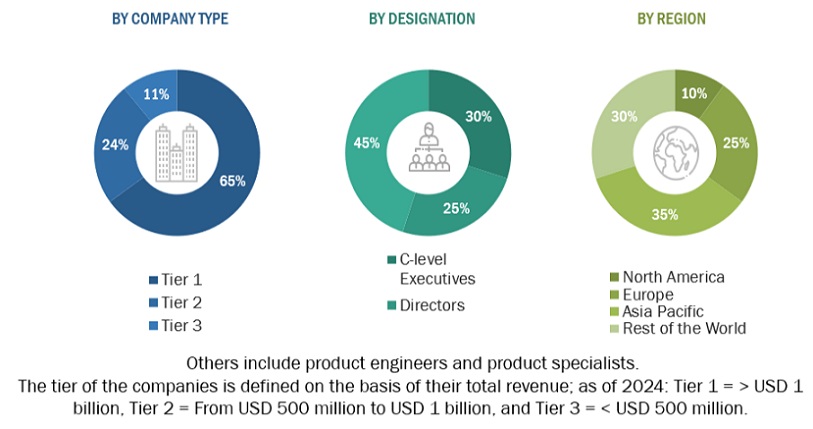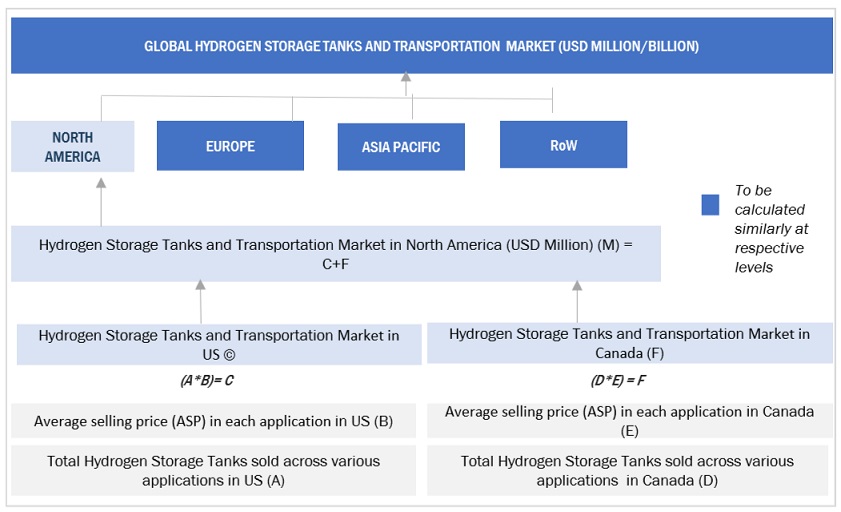The study involved major activities in estimating the current size of the hydrogen storage tanks and transportation market. Exhaustive secondary research was done to collect information on the peer and parent markets. The next step was to validate these findings, assumptions, and sizing with industry experts across the value chain through primary research. Both top-down and bottom-up approaches were employed to estimate the total market size. Thereafter, market breakdown and data triangulation were used to estimate the market size of the segments and subsegments.
Secondary Research
This research study on the hydrogen storage tanks and transportation market involved the use of extensive secondary sources, directories, and databases, such as Hoover’s, Bloomberg, Factiva, IRENA, International Energy Agency, and Statista Industry Journal, to collect and identify information useful for a technical, market-oriented, and commercial study of the hydrogen storage tanks and transportation market. The other secondary sources included annual reports, press releases & investor presentations of companies, white papers, certified publications, articles by recognized authors, manufacturer associations, trade directories, and databases.
Primary Research
The hydrogen storage tanks and transportation market comprises several stakeholders, such as hydrogen storage tanks and transportation manufacturers, technology providers, and technical support providers in the supply chain. The demand side of this market is characterized by the rising demand for storage solutions in various applications such as energy, mobility, industrial, and transportation. The supply side is characterized by rising demand for contracts from the industrial sector and mergers & acquisitions among big players. Various primary sources from both the supply and demand sides of the market were interviewed to obtain qualitative and quantitative information. Following is the breakdown of primary respondents:

To know about the assumptions considered for the study, download the pdf brochure
Market Size Estimation
Both top-down and bottom-up approaches were used to estimate and validate the total size of the hydrogen storage tanks and transportation market. These methods were also used extensively to estimate the size of various subsegments in the market. The research methodology used to estimate the market size includes the following:
-
The key players in the industry and market have been identified through extensive secondary research, and their market share has been determined through primary and secondary research.
-
The industry’s value chain and market size, in terms of value, have been determined through both primary and secondary research processes.
-
All percentage shares, splits, and breakdowns have been determined using secondary sources and verified through primary sources.
Hydrogen Storage Tanks and Transportation Market Size: Top-Down Approach

To know about the assumptions considered for the study, Request for Free Sample Report
Hydrogen Storage Tanks and Transportation Market Size: Bottom-Up Approach

Data Triangulation
After arriving at the overall market size from the above estimation process, the total market has been split into several segments and subsegments. Data triangulation and market breakdown processes have been employed to complete the overall market engineering process and arrive at the exact statistics for all the segments and sub-segments, wherever applicable. The data has been triangulated by studying various factors and trends from both the demand- and supply sides. Along with this, the market has been validated using both the top-down and bottom-up approaches.
Market Definition
Hydrogen can be stored or transported in cylinders, tubes, and cryogenic tanks as a compressed gas or cryogenic liquid for industrial usage or as a propellant in space missions. Hydrogen can be stored in three ways: as compressed gas in high-pressure tanks, as a liquid at -253°C in dewars, or in chemical form by reacting or adsorbing with chemicals or metal compounds. When resources run short, hydrogen stored in various forms can be recovered. In contrast to the energy held in batteries, which declines over time, hydrogen may be stored for extended periods.
Key Stakeholders
-
Hydrogen Storage Tanks and Transportation Dealers and Suppliers
-
Government and Research Organizations
-
Power and Energy Associations
-
Repairs and Maintenance Service Providers
-
State and National Regulatory Authorities
-
Research And Consulting Companies in the Clean Energy Generation Sector
-
Organizations, Forums, Alliances, And Associations
-
Industrial Authorities and Association
State and National Regulatory Authorities Objectives of the Study
-
To define, describe, segment, and forecast the hydrogen storage tanks and transportation market size, by tank type, pressure, modular storage, material type and application, in terms of value.
-
To forecast the hydrogen storage tanks and transportation market size, by tank type, and application in terms of volume.
-
To forecast the market size across four key regions: North America, Europe, Asia Pacific, and RoW, along with country-level analysis, in terms of value and volume.
-
To describe key elements required to manufacture a hydrogen storage tanks and transportation.
-
To provide statistical data for installed hydrogen storage tanks and transportation for each region and country.
-
To provide detailed information regarding key drivers, restraints, opportunities, and challenges influencing the market growth.
-
To provide the supply chain analysis, trends/disruptions impacting customer business, market mapping, pricing analysis, and regulatory landscape pertaining to the hydrogen storage tanks and transportation market.
-
To strategically analyze the ecosystem, standards and regulations, patent analysis, trade analysis, Porter’s five forces, and case studies pertaining to the market under study.
-
To strategically analyze micromarkets1 with respect to individual growth trends, prospects, contributions to the overall market size.
-
To analyze opportunities for stakeholders in the hydrogen storage tanks and transportation market and draw a competitive landscape for market players.
-
To benchmark players within the market using the company evaluation matrix, which analyzes market players based on several parameters within the broad categories of business and product strategies.
-
To compare the key market players with respect to the market share, product specifications, and applications.
-
To strategically profile the key players and comprehensively analyze their market ranking and core competencies.
-
To analyze competitive developments in the hydrogen storage tanks and transportation market, such as contracts, agreements, investments, expansions, product launches, partnerships, joint ventures, and collaborations.
Available Customizations:
With the given market data, MarketsandMarkets offers customizations according to the specific requirements of companies. The following customization options are available for the report:
Product Analysis
-
Product Matrix, which provides a detailed comparison of the product portfolio of each company
Company Information
-
Detailed analyses and profiling of additional market players



Growth opportunities and latent adjacency in Hydrogen Storage Tanks and Transportation Market